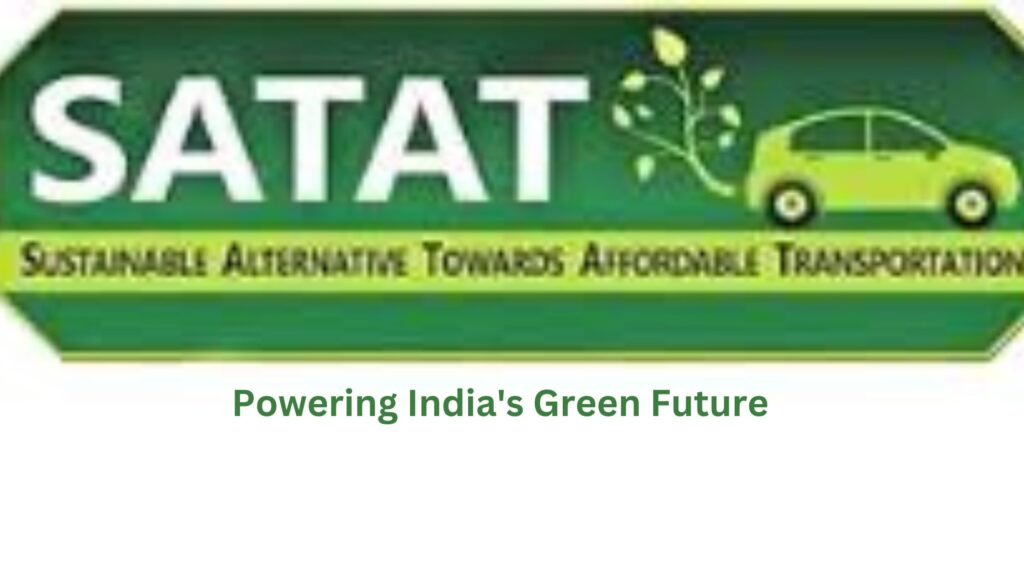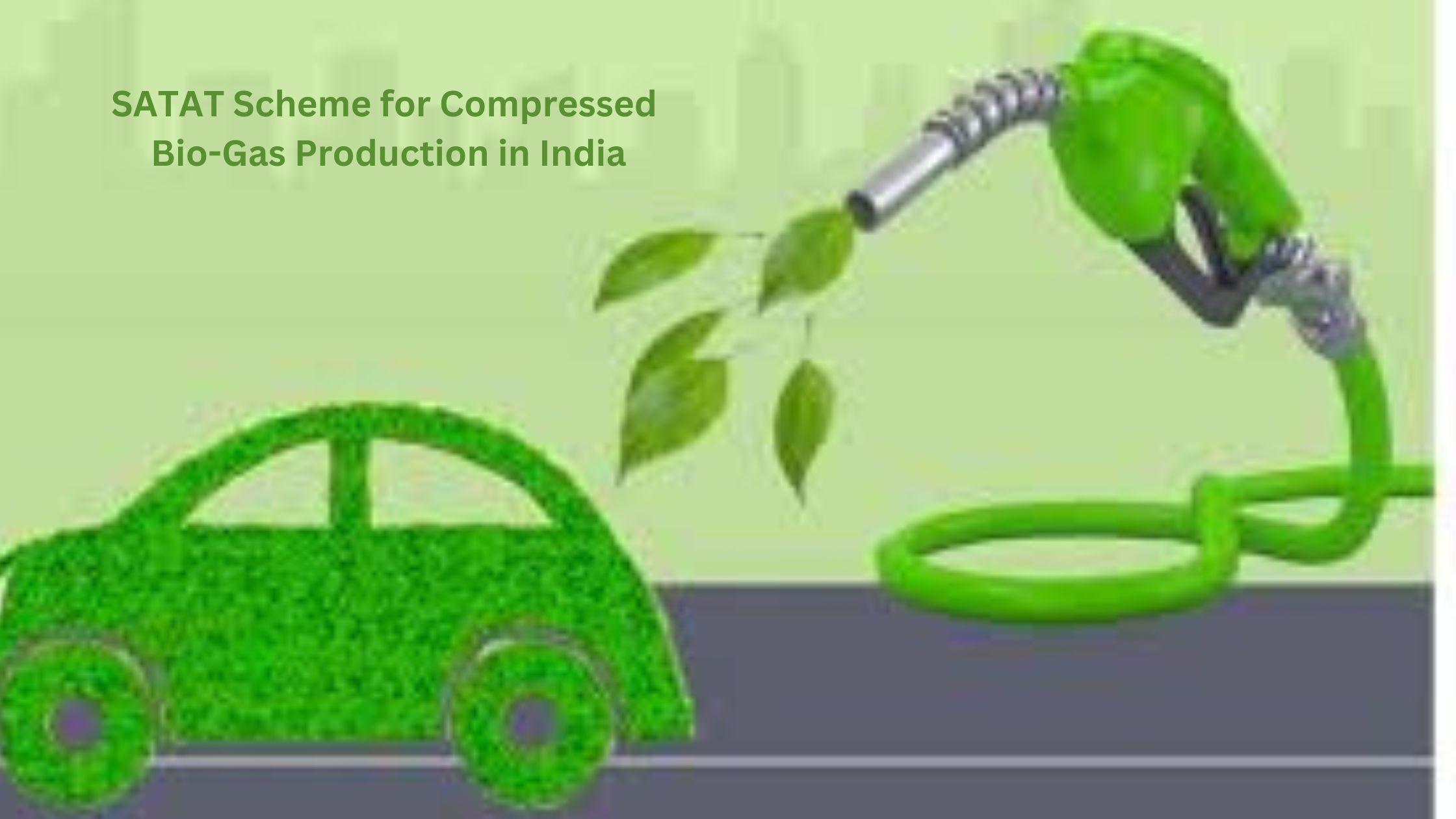
Learn about Sustainable Alternative Towards Affordable Transportation (SATAT), a revolutionary scheme promoting Compressed Bio Gas (CBG) as a clean and affordable transport fuel in India. Discover its benefits for the environment, farmers, and the nation’s economy.
India is on a mission to achieve sustainable development, and the transportation sector plays a crucial role in this journey. The SATAT (Sustainable Alternative Towards Affordable Transportation) scheme, launched in 2018, is a groundbreaking initiative promoting Compressed Bio Gas (CBG) as a clean and affordable alternative fuel. This article explores SATAT’s benefits, its role in waste management, and its contribution to a greener future for India.
What is CBG?

Compressed Bio Gas (CBG) is a renewable fuel derived from organic waste materials like agricultural residue, cattle dung, and municipal solid waste. Through a process called anaerobic digestion, these organic materials decompose in an oxygen-free environment, producing biogas. CBG is purified biogas compressed to a similar pressure as Liquefied Petroleum Gas (LPG), making it a viable transportation fuel.
Objectives of the Sustainable Alternative Towards Affordable Transportation (SATAT) Scheme
The key objectives are:
- Utilization of agricultural residue, cattle dung and municipal solid waste for producing CBG
- Reduction of natural gas imports by replacing it with CBG
- Providing an additional source of income to farmers
- Creating new employment opportunities in the CBG production sector
- Reducing greenhouse gas emissions and improving waste management practices
Benefits
The SATAT scheme offers a multitude of advantages for India’s environment, economy, and society:
- Environmental Benefits: CBG is a clean-burning fuel that significantly reduces greenhouse gas emissions compared to traditional fossil fuels. This helps combat air pollution and mitigates climate change.
- Waste Management Solution: SATAT promotes the utilization of organic waste, reducing landfill burdens and promoting sustainable waste management practices.
- Economic Benefits: SATAT encourages the establishment of CBG plants, creating rural employment opportunities and boosting the bio-energy sector.
- Farmer Empowerment: The scheme provides farmers with an additional income stream by creating a market for agricultural residue and cattle dung.
- Reduced Dependence on Crude Oil Imports: Widespread adoption of CBG can decrease India’s reliance on imported crude oil, enhancing energy security and economic independence.
- Alignment with Swachhta Hi Seva: SATAT aligns with the Swachhta Hi Seva mission by promoting cleanliness and efficient waste management.
Benefits for farmers
The benefits of the SATAT scheme for farmers include:
- Additional Revenue Source: Farmers can earn extra income by supplying agricultural residue, cattle dung, and municipal solid waste to the Compressed Bio-Gas (CBG) plants established under the SATAT scheme.
- Reduction in Biomass Burning: The scheme helps in improving air quality by preventing the burning of biomass, which is a common practice in many agricultural areas. By utilizing these waste materials for CBG production, the scheme contributes to reducing pollution and environmental degradation.
- Boost to Entrepreneurship: SATAT encourages entrepreneurship among farmers by providing them with an opportunity to participate in the production of CBG. This initiative supports rural economic development and empowers farmers to engage in sustainable energy practices.
- Support for Climate Change Goals: The utilization of agricultural residue, cattle dung, and municipal solid waste for CBG production aligns with national commitments to reduce carbon emissions and combat climate change. By promoting the use of CBG, the SATAT scheme contributes to achieving environmental sustainability goals.
- Reduction in Import Dependence: By producing CBG locally from organic waste sources, the SATAT scheme helps in reducing the dependence on imported fossil fuels like natural gas and diesel. This enhances energy security and reduces the country’s reliance on external fuel sources.
- Buffer Against Price Fluctuations: The scheme provides a buffer against fluctuations in crude oil and gas prices by promoting the production and use of a renewable and sustainable fuel like CBG. This can help farmers and the economy withstand price volatility in the energy sector.
Overall, the SATAT scheme offers a range of benefits to farmers, including income generation, environmental conservation, and participation in sustainable energy practices.
How Does it Work?
SATAT focuses on encouraging independent entrepreneurs to set up CBG plants. Oil marketing companies (OMCs) play a crucial role by:
- Inviting Expressions of Interest (EOI) from potential entrepreneurs for establishing CBG plants.
- Offering floor prices for CBG purchases through long-term commercial agreements.
- Facilitating the marketing of CBG through their existing fuel station networks.
Implementation
The SATAT scheme is being implemented in the following manner:
- Invitation for Expression of Interest (EOI): OMCs have invited EOIs from potential entrepreneurs to set up CBG production plants and supply CBG to them.
- Identification of potential sites: Entrepreneurs are required to identify potential sites for setting up CBG plants based on the availability of feedstock (agricultural residue, cattle dung, municipal solid waste).
- Signing of Memorandum of Understanding (MoU): Successful entrepreneurs will sign an MoU with the OMCs for the supply of CBG.
- Establishment of CBG plants: Entrepreneurs will set up CBG plants with the required infrastructure and technology.
- Supply of CBG to OMCs: Once the plants are operational, entrepreneurs will supply the produced CBG to the OMCs as per the agreed terms and conditions.
Progress
As of March 2023, the following progress has been made under the SATAT scheme:
- 1,500+ Entrepreneurs have submitted EOIs to set up CBG plants
- 500+ CBG plants have been granted Letter of Intent (LOI) by OMCs
- 100+ CBG plants are currently operational with a total production capacity of 3,700 TPD (Tonnes Per Day)
- 50+ CBG plants are under construction with a total production capacity of 1,500 TPD
Challenges and Way Forward
While the SATAT scheme has made significant progress, there are still some challenges that need to be addressed:
- Lack of awareness among farmers about the scheme and its benefits
- Limited availability of feedstock in some regions due to competing uses
- High capital costs for setting up CBG plants
- Lack of skilled manpower for operating and maintaining CBG plants
To overcome these challenges, the government and stakeholders need to focus on the following:
- Increasing awareness about the scheme among farmers and entrepreneurs
- Providing financial incentives and subsidies to reduce the capital costs of CBG plants
- Investing in research and development to improve the efficiency and cost-effectiveness of CBG production technologies
- Developing a skilled workforce through training and capacity building programs
FAQs
Who can participate in this scheme?
The scheme is open to independent entrepreneurs interested in setting up CBG plants.
What are the feedstocks used for CBG production?
Agricultural residue, cattle dung, and municipal solid waste are the primary feedstocks.
What are the benefits for CBG plant owners?
Entrepreneurs benefit from government support, long-term purchase agreements with OMCs, and the potential for a profitable bio-energy business.
How does SATAT contribute to Swachhta Hi Seva?
By promoting the use of organic waste for fuel production,it helps achieve cleaner communities and efficient waste management.
Conclusion
this scheme is a visionary initiative paving the way for a sustainable transportation future in India. By promoting CBG, SATAT addresses environmental concerns, empowers farmers, and stimulates economic growth. As the scheme gains momentum, India can achieve its clean energy goals, reduce dependence on fossil fuels, and create a cleaner and more prosperous future for all.

